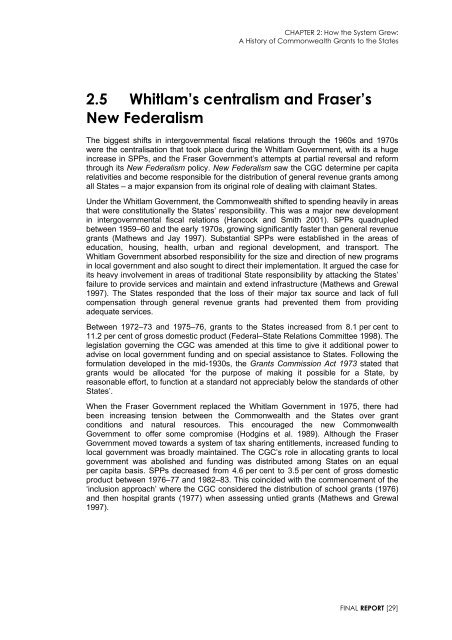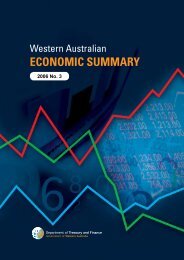Garnaut Fitzgerald Review of Commonwealth-State Funding
Garnaut Fitzgerald Review of Commonwealth-State Funding
Garnaut Fitzgerald Review of Commonwealth-State Funding
Create successful ePaper yourself
Turn your PDF publications into a flip-book with our unique Google optimized e-Paper software.
CHAPTER 2: How the System Grew:<br />
A History <strong>of</strong> <strong>Commonwealth</strong> Grants to the <strong>State</strong>s<br />
2.5 Whitlam’s centralism and Fraser’s<br />
New Federalism<br />
The biggest shifts in intergovernmental fiscal relations through the 1960s and 1970s<br />
were the centralisation that took place during the Whitlam Government, with its a huge<br />
increase in SPPs, and the Fraser Government’s attempts at partial reversal and reform<br />
through its New Federalism policy. New Federalism saw the CGC determine per capita<br />
relativities and become responsible for the distribution <strong>of</strong> general revenue grants among<br />
all <strong>State</strong>s – a major expansion from its original role <strong>of</strong> dealing with claimant <strong>State</strong>s.<br />
Under the Whitlam Government, the <strong>Commonwealth</strong> shifted to spending heavily in areas<br />
that were constitutionally the <strong>State</strong>s’ responsibility. This was a major new development<br />
in intergovernmental fiscal relations (Hancock and Smith 2001). SPPs quadrupled<br />
between 1959–60 and the early 1970s, growing significantly faster than general revenue<br />
grants (Mathews and Jay 1997). Substantial SPPs were established in the areas <strong>of</strong><br />
education, housing, health, urban and regional development, and transport. The<br />
Whitlam Government absorbed responsibility for the size and direction <strong>of</strong> new programs<br />
in local government and also sought to direct their implementation. It argued the case for<br />
its heavy involvement in areas <strong>of</strong> traditional <strong>State</strong> responsibility by attacking the <strong>State</strong>s’<br />
failure to provide services and maintain and extend infrastructure (Mathews and Grewal<br />
1997). The <strong>State</strong>s responded that the loss <strong>of</strong> their major tax source and lack <strong>of</strong> full<br />
compensation through general revenue grants had prevented them from providing<br />
adequate services.<br />
Between 1972–73 and 1975–76, grants to the <strong>State</strong>s increased from 8.1 per cent to<br />
11.2 per cent <strong>of</strong> gross domestic product (Federal–<strong>State</strong> Relations Committee 1998). The<br />
legislation governing the CGC was amended at this time to give it additional power to<br />
advise on local government funding and on special assistance to <strong>State</strong>s. Following the<br />
formulation developed in the mid-1930s, the Grants Commission Act 1973 stated that<br />
grants would be allocated ‘for the purpose <strong>of</strong> making it possible for a <strong>State</strong>, by<br />
reasonable effort, to function at a standard not appreciably below the standards <strong>of</strong> other<br />
<strong>State</strong>s’.<br />
When the Fraser Government replaced the Whitlam Government in 1975, there had<br />
been increasing tension between the <strong>Commonwealth</strong> and the <strong>State</strong>s over grant<br />
conditions and natural resources. This encouraged the new <strong>Commonwealth</strong><br />
Government to <strong>of</strong>fer some compromise (Hodgins et al. 1989). Although the Fraser<br />
Government moved towards a system <strong>of</strong> tax sharing entitlements, increased funding to<br />
local government was broadly maintained. The CGC’s role in allocating grants to local<br />
government was abolished and funding was distributed among <strong>State</strong>s on an equal<br />
per capita basis. SPPs decreased from 4.6 per cent to 3.5 per cent <strong>of</strong> gross domestic<br />
product between 1976–77 and 1982–83. This coincided with the commencement <strong>of</strong> the<br />
‘inclusion approach’ where the CGC considered the distribution <strong>of</strong> school grants (1976)<br />
and then hospital grants (1977) when assessing untied grants (Mathews and Grewal<br />
1997).<br />
FINAL REPORT [29]

















